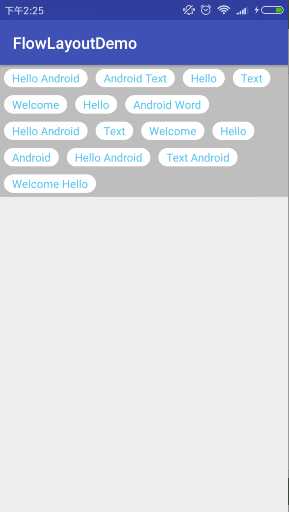标签:dimens padding clear log prot roi lock measure private
一、流式布局效果

二、工程结构

三、新建工程,自定义GroupView(流式布局)

package com.yuanlei.flowlayoutdemo; import android.content.Context; import android.util.AttributeSet; import android.util.Log; import android.view.View; import android.view.ViewGroup; import java.util.ArrayList; import java.util.List; /** * Created by 袁磊 on 2017/2/17. */ public class FlowLayout extends ViewGroup { public FlowLayout(Context context) { //调用两个参数的构造方法 this(context, null); } public FlowLayout(Context context, AttributeSet attrs) { //调用三个参数的构造方法 this(context, attrs, 0); } public FlowLayout(Context context, AttributeSet attrs, int defStyleAttr) { super(context, attrs, defStyleAttr); } @Override protected void onMeasure(int widthMeasureSpec, int heightMeasureSpec) { int sizeWidth = MeasureSpec.getSize(widthMeasureSpec);//Group宽度 int modeWidth = MeasureSpec.getMode(widthMeasureSpec);//Group宽度测量模式 int sizeHeight = MeasureSpec.getSize(heightMeasureSpec);//Group高度 int modeHeight = MeasureSpec.getMode(heightMeasureSpec);//Group高度测量模式 //wrap_content情况下的宽高 int width = 0; int height = 0; //记录每一行的总宽度和高度 int lineWidth = 0; int lineHeight = 0; //得到内部元素的个数 int cCount = getChildCount(); for (int i = 0; i < cCount; i++) { View child = getChildAt(i); //测量子View的宽和高 measureChild(child, widthMeasureSpec, heightMeasureSpec); //得到子View的LayoutParams MarginLayoutParams lp = (MarginLayoutParams) child.getLayoutParams(); //子View占据的宽度 int childWidth = child.getMeasuredWidth() + lp.leftMargin + lp.rightMargin; //子View占据的高度 int childHeight = child.getMeasuredHeight() + lp.topMargin + lp.bottomMargin; //换行时 if (lineWidth + childWidth > sizeWidth - getPaddingLeft() - getPaddingRight()) {//(当前第一行宽度)+(一个子View宽度)>(控件宽度) //对比得到最大的行宽度 width = Math.max(width, lineWidth); //重置lineWidth lineWidth = childWidth; //记录行高 height += lineHeight; lineHeight = childHeight; } else {//不换行时 //叠加行宽 lineWidth += childWidth; //得到当前行最大的高度 lineHeight = Math.max(lineHeight, childHeight); } //最后一个子控件 if (i == cCount - 1) { width = Math.max(lineWidth, width); height += lineHeight; } } Log.d("TAG", "sizeWidth=" + sizeWidth); Log.d("TAG", "sizeHeight=" + sizeHeight); setMeasuredDimension( modeWidth == MeasureSpec.EXACTLY ? sizeWidth : width + getPaddingLeft() + getPaddingRight(), modeHeight == MeasureSpec.EXACTLY ? sizeHeight : height + getPaddingTop() + getPaddingBottom()); } //存储所有的View(注:一行一行存储) private List<List<View>> mAllViews = new ArrayList<>(); //每一行的高度 private List<Integer> mLineHeight = new ArrayList<>(); @Override protected void onLayout(boolean changed, int l, int t, int r, int b) { mAllViews.clear(); mLineHeight.clear(); //当前ViewGroup的宽度 int width = getWidth(); int lineWidth = 0; int lineHeight = 0; List<View> lineViews = new ArrayList<>(); int cCount = getChildCount(); for (int i = 0; i < cCount; i++) { View child = getChildAt(i); MarginLayoutParams lp = (MarginLayoutParams) child.getLayoutParams(); int childWidth = child.getMeasuredWidth(); int childHeight = child.getMeasuredHeight(); //如果需要换行 if (childWidth + lineWidth + lp.leftMargin + lp.rightMargin > width - getPaddingLeft() - getPaddingRight()) { //记录LineHeight mLineHeight.add(lineHeight); //记录当前行所有的子View mAllViews.add(lineViews); //重置我们的行宽和行高 lineWidth = 0; lineHeight = childHeight + lp.topMargin + lp.bottomMargin; //重置我们的集合 lineViews = new ArrayList<>(); } lineWidth += childWidth + lp.leftMargin + lp.rightMargin; lineHeight = Math.max(lineHeight, childHeight + lp.topMargin + lp.bottomMargin); lineViews.add(child); }//for循环结束 //处理最后一行 mLineHeight.add(lineHeight); mAllViews.add(lineViews); //设置子View的位置 int left = getPaddingLeft(); int top = getPaddingTop(); //行数 int lineNum = mAllViews.size(); for (int i = 0; i < lineNum; i++) { //当前行的所有的View(每行整体) lineViews = mAllViews.get(i); lineHeight = mLineHeight.get(i); //遍历每一行的所有View(每行里面的子View) for (int j = 0; j < lineViews.size(); j++) { View child = lineViews.get(j); //判读child的状态 if (child.getVisibility() == View.GONE) { continue; } MarginLayoutParams lp = (MarginLayoutParams) child.getLayoutParams(); //child的left,right,top,bottom int lc = left + lp.leftMargin; int rc = lc + child.getMeasuredWidth(); int tc = top + lp.topMargin; int bc = tc + child.getMeasuredHeight(); //为子View进行布局 child.layout(lc, tc, rc, bc); //在每一行中的子View,只需要改变left的位置,高度一样 left += child.getMeasuredWidth() + lp.leftMargin + lp.rightMargin; } left = getPaddingLeft(); top += lineHeight; } } /** * 与当前ViewGroup对应的LayoutParams */ @Override public LayoutParams generateLayoutParams(AttributeSet attrs) { return new MarginLayoutParams(getContext(), attrs); } }
四、流式布局中子View(TextView)的shape

<?xml version="1.0" encoding="utf-8"?>
<shape xmlns:android="http://schemas.android.com/apk/res/android">
<solid android:color="#ffffff" />
<corners android:radius="30dp" />
<padding
android:bottom="2dp"
android:left="10dp"
android:right="10dp"
android:top="2dp" />
</shape>
五、流式布局中的子View(TextView)

<?xml version="1.0" encoding="utf-8"?> <TextView xmlns:android="http://schemas.android.com/apk/res/android" android:layout_width="wrap_content" android:layout_height="wrap_content" android:layout_margin="5dp" android:background="@drawable/tv_bg" android:text="Hello Word" android:textColor="#5bc4ed" />
六、使用流式布局

<?xml version="1.0" encoding="utf-8"?> <TextView xmlns:android="http://schemas.android.com/apk/res/android" android:layout_width="wrap_content" android:layout_height="wrap_content" android:layout_margin="5dp" android:background="@drawable/tv_bg" android:text="Hello Word" android:textColor="#5bc4ed" />
布局文件:

<?xml version="1.0" encoding="utf-8"?> <RelativeLayout xmlns:android="http://schemas.android.com/apk/res/android" android:layout_width="match_parent" android:layout_height="match_parent"> <com.yuanlei.flowlayoutdemo.FlowLayout android:id="@+id/my_fl_main" android:layout_width="match_parent" android:layout_height="wrap_content" android:background="#33000000" /> </RelativeLayout>
七、知识点
1、自定义ViewGroup:
1.onMeasure:测量子View的宽和高,设置自己的宽和高
2.onLayout:设置子View的位置
onMeasure:根据子View的布局文件,为子View设置测量模式和测量值
测量=测量模式+测量值
测量模式:3种
1.EXACTLY:100dp(直接设置),match_parent
2.AT_MOST:wrap_content
3.UNSPCIIFIED:子控件想要多大就多大(很少见)
标签:dimens padding clear log prot roi lock measure private
原文地址:http://www.cnblogs.com/bky1225987336/p/6413189.html